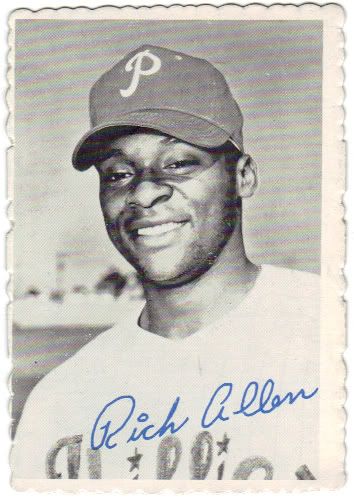I have a tendency to start features and then ignore them for months upon months. It amazes me that bloggers such as Night Owl can not only start such ambitious tasks as the 50 greatest card backs of all time, but also maintain and complete them.
This series started in early November. It’s now basically mid-July and I’m welcoming you to episode 2. I guess I need to write some of these ideas down somewhere. That way I’ll see them and remember to re-visit the concept instead of letting it fall into the abyss of archived blog posts never to be viewed again.
For those that need a refresher, and let’s be honest – we all do, I went to my parents’ house back in the long, long ago and raided some of the crazy pre-1986 cards that somehow wound up in my collection during the first stint as a kid. Mixed in with droves of 1991 Fleer and 1992 Topps were hidden gems begging to be let loose from the junkwax quicksand. I safely plucked them all out and will be featuring some here (albeit sporadically).
They are:
THE CARDS I DIDN’T KNOW I HAD – Part 2 in a series of however many I end up finding

I'll admit I had to look this card up
What we have here is a 1969 Topps Deckle Edge Richie Allen — Card #26. Sure it’s off-center but otherwise it’s in decent shape. The edges look at little rough on the back, but could be a lot worse for a card this old.
As a pre-teen, I can only assume that I thought this card was either really cool because it was so different or an old die-cut, or I thought someone randomly cut pieces off of the border as if trying and failing to make a paper snowflake. I doubt I made any sort of stamp or picture frame connection.
Dick Allen spent the first 5 years of his career in Philly (and would return in 75 & 76), winning the Rookie of the Year award in 1964. He also finished 7th in MVP voting that year, although the numbers say he probably should have been higher. He led the league in runs, triples, extra base hits and total bases. He was in the top 5 in batting average (.318), hits and doubles. Not too shabby. The fans didn’t always like him, though. He was known as “Crash Helmet” because he would wear his batting helmet on the field to avoid the barrage of fruit, batteries and other items fans would throw. Hell, even his own teammate Frank Thomas swung a bat at him, resulting in Thomas’ firing. It’s this kind of behavior and racist reaction that the Milton Bradleys of the world believe in their minds they are experiencing out on the field today. No…you just suck and fans are tired of it.
Like Bradley, Allen was seen as a poor clubhouse presence, possibly a result of the Thomas bat incident. It’s hurt his Hall of Fame chances amongst voters who believe he detracted from others as much as he contributed. And Allen did contribute. The Wampum Walloper hit 351 HR over 15 seasons (a few injury shortened). He’s well-known for smacking the snot out of the ball and hitting some of the most towering and farthest flying home runs anyone has ever seen. He also ended his career with a .292 AVG with over 1,000 RBIs, 1800 hits, 320 2B, 79 3B, 7 all-star appearances, and an AL MVP award. I can see why he would be considered borderline by the committee, but I wonder if voters put too much weight on length of career and milestone numbers. A man could be nearly dominant for 10 years but those 5 where he struggled all of a sudden mean he’s not worthy to most. Or he could be dominant for 10, but only play 11 and that’s not enough for some reason. I don’t know. What do you say?
His, like just about any other player’s, history is an interesting one, and it’s something I would not have explored were it not for this card that I found again in a random shoebox in my basement. I don’t know how I ended up with it, but I thank it for guiding me towards a fun little history lesson. Learning more about the players makes cards like this so much more valuable.

Baseball is a numbers game and I can see why they use the numbers to guide Hall of Fame selections. It seems like there are these “magic” numbers…500 homers, 3000 hits, 300 wins. The issue is that guys today can play longer. They have state of the art medical care and trainers that can keep them on the field. One thing that they don’t have anymore is the “greenies”. Those little go pills that were so prevalent in the last few decades. I think that may be why the numbers are down for so many guys this year, but I’m getting off on a tangent.
Back to the point. You’ll hear talk about whether someone is Hall of Fame worthy and it generally comes down to a) were they dominant at their position at least a part of their career and b) do they have the numbers to support it. Things like how they interacted with the media comes up too, with guys like Eddie Murray, but it really shouldn’t. I guess in the end, it’s the Hall of Fame, not the Hall of Very Good. I imagine if they opened it up to everyone with good numbers, there would be a whole slew of players that might be considered.
Just my rambling, not thought out, late at night musings on an interesting topic.
By the way, I love going through cards I haven’t looked at in a while to see what forgotten treasures are hidden away.